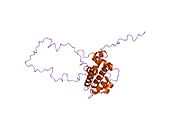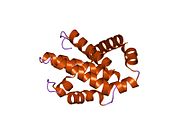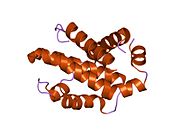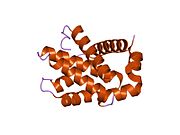BCL2L1
پروتئین ۱ شبه Bcl-2 (انگلیسی: BCL2-like 1) یک ژن در انسان است. این ژن، از طریق «پیرایش دگرسان»، دو پروتئین «Bcl-xL» و «Bcl-xS» را کُدگذاری میکند[۴] که اولی فعالکنندهٔ آپوپتوز و دومی بازدارندهٔ آپوپتوز است.[۴][۵]
عملکرد[ویرایش]
پروتئین حاصل از این ژن که در غشاء بیرونی میتوکندری جای دارد، به خانواده Bcl-2 تعلق داشته و در تنظیم فرایند آپوپتوز دخالت دارد.
تعاملهای شیمیایی[ویرایش]
این پروتئین با مولکولهای زیر تعامل پروتئین-پروتئین دارد:
- APAF1[۶][۷]
- PPP1CA[۸]
- RAD9A[۹][۱۰]
- BIK[۹][۱۱][۱۲][۱۳]
- BAK1[۹][۱۴][۱۵][۱۶][۱۷]
- BAD[۱۴][۱۱][۱۰][۱۸][۸][۱۹][۲۰][۲۱][۲۲][۲۳][۲۴]
- BAX[۱۴][۱۸][۲۵][۱۲]
منابع[ویرایش]
- ↑ ۱٫۰ ۱٫۱ ۱٫۲ GRCm38: Ensembl release 89: ENSMUSG00000007659 - Ensembl, May 2017
- ↑ "Human PubMed Reference:". National Center for Biotechnology Information, U.S. National Library of Medicine.
- ↑ "Mouse PubMed Reference:". National Center for Biotechnology Information, U.S. National Library of Medicine.
- ↑ ۴٫۰ ۴٫۱ Boise LH, González-García M, Postema CE, Ding L, Lindsten T, Turka LA, Mao X, Nuñez G, Thompson CB (Aug 1993). "bcl-x, a bcl-2-related gene that functions as a dominant regulator of apoptotic cell death" (PDF). Cell. 74 (4): 597–608. doi:10.1016/0092-8674(93)90508-N. hdl:2027.42/30629. PMID 8358789. S2CID 13542617.
- ↑ "Entrez Gene: BCL2L1 BCL2-like 1".
- ↑ Hu Y, Benedict MA, Wu D, Inohara N, Núñez G (Apr 1998). "Bcl-XL interacts with Apaf-1 and inhibits Apaf-1-dependent caspase-9 activation". Proceedings of the National Academy of Sciences of the United States of America. 95 (8): 4386–91. Bibcode:1998PNAS...95.4386H. doi:10.1073/pnas.95.8.4386. PMC 22498. PMID 9539746.
- ↑ Pan G, O'Rourke K, Dixit VM (Mar 1998). "Caspase-9, Bcl-XL, and Apaf-1 form a ternary complex". The Journal of Biological Chemistry. 273 (10): 5841–5. doi:10.1074/jbc.273.10.5841. PMID 9488720.
- ↑ ۸٫۰ ۸٫۱ Ayllón V, Cayla X, García A, Fleischer A, Rebollo A (Jul 2002). "The anti-apoptotic molecules Bcl-xL and Bcl-w target protein phosphatase 1alpha to Bad". European Journal of Immunology. 32 (7): 1847–55. doi:10.1002/1521-4141(200207)32:7<1847::AID-IMMU1847>3.0.CO;2-7. PMID 12115603.
- ↑ ۹٫۰ ۹٫۱ ۹٫۲ Rual JF, Venkatesan K, Hao T, Hirozane-Kishikawa T, Dricot A, Li N, Berriz GF, Gibbons FD, Dreze M, Ayivi-Guedehoussou N, Klitgord N, Simon C, Boxem M, Milstein S, Rosenberg J, Goldberg DS, Zhang LV, Wong SL, Franklin G, Li S, Albala JS, Lim J, Fraughton C, Llamosas E, Cevik S, Bex C, Lamesch P, Sikorski RS, Vandenhaute J, Zoghbi HY, Smolyar A, Bosak S, Sequerra R, Doucette-Stamm L, Cusick ME, Hill DE, Roth FP, Vidal M (Oct 2005). "Towards a proteome-scale map of the human protein-protein interaction network". Nature. 437 (7062): 1173–8. Bibcode:2005Natur.437.1173R. doi:10.1038/nature04209. PMID 16189514. S2CID 4427026.
- ↑ ۱۰٫۰ ۱۰٫۱ Komatsu K, Miyashita T, Hang H, Hopkins KM, Zheng W, Cuddeback S, Yamada M, Lieberman HB, Wang HG (Jan 2000). "Human homologue of S. pombe Rad9 interacts with BCL-2/BCL-xL and promotes apoptosis". Nature Cell Biology. 2 (1): 1–6. doi:10.1038/71316. PMID 10620799. S2CID 52847351.
- ↑ ۱۱٫۰ ۱۱٫۱ Chen L, Willis SN, Wei A, Smith BJ, Fletcher JI, Hinds MG, Colman PM, Day CL, Adams JM, Huang DC (Feb 2005). "Differential targeting of prosurvival Bcl-2 proteins by their BH3-only ligands allows complementary apoptotic function". Molecular Cell. 17 (3): 393–403. doi:10.1016/j.molcel.2004.12.030. PMID 15694340.
- ↑ ۱۲٫۰ ۱۲٫۱ Gillissen B, Essmann F, Graupner V, Stärck L, Radetzki S, Dörken B, Schulze-Osthoff K, Daniel PT (Jul 2003). "Induction of cell death by the BH3-only Bcl-2 homolog Nbk/Bik is mediated by an entirely Bax-dependent mitochondrial pathway". The EMBO Journal. 22 (14): 3580–90. doi:10.1093/emboj/cdg343. PMC 165613. PMID 12853473.
- ↑ Jiang A, Clark EA (May 2001). "Involvement of Bik, a proapoptotic member of the Bcl-2 family, in surface IgM-mediated B cell apoptosis". Journal of Immunology. 166 (10): 6025–33. doi:10.4049/jimmunol.166.10.6025. PMID 11342619.
- ↑ ۱۴٫۰ ۱۴٫۱ ۱۴٫۲ Zhang H, Nimmer P, Rosenberg SH, Ng SC, Joseph M (Aug 2002). "Development of a high-throughput fluorescence polarization assay for Bcl-x(L)". Analytical Biochemistry. 307 (1): 70–5. doi:10.1016/S0003-2697(02)00028-3. PMID 12137781.
- ↑ Whitfield J, Harada K, Bardelle C, Staddon JM (Nov 2003). "High-throughput methods to detect dimerization of Bcl-2 family proteins". Analytical Biochemistry. 322 (2): 170–8. doi:10.1016/j.ab.2003.07.014. PMID 14596824.
- ↑ Willis SN, Chen L, Dewson G, Wei A, Naik E, Fletcher JI, Adams JM, Huang DC (Jun 2005). "Proapoptotic Bak is sequestered by Mcl-1 and Bcl-xL, but not Bcl-2, until displaced by BH3-only proteins". Genes & Development. 19 (11): 1294–305. doi:10.1101/gad.1304105. PMC 1142553. PMID 15901672.
- ↑ Degterev A, Lugovskoy A, Cardone M, Mulley B, Wagner G, Mitchison T, Yuan J (Feb 2001). "Identification of small-molecule inhibitors of interaction between the BH3 domain and Bcl-xL". Nature Cell Biology. 3 (2): 173–82. doi:10.1038/35055085. PMID 11175750. S2CID 32934759.
- ↑ ۱۸٫۰ ۱۸٫۱ Strobel T, Tai YT, Korsmeyer S, Cannistra SA (Nov 1998). "BAD partly reverses paclitaxel resistance in human ovarian cancer cells". Oncogene. 17 (19): 2419–27. doi:10.1038/sj.onc.1202180. PMID 9824152.
- ↑ Jin Z, Xin M, Deng X (Apr 2005). "Survival function of protein kinase C{iota} as a novel nitrosamine 4-(methylnitrosamino)-1-(3-pyridyl)-1-butanone-activated bad kinase". The Journal of Biological Chemistry. 280 (16): 16045–52. doi:10.1074/jbc.M413488200. PMID 15705582.
- ↑ Yang E, Zha J, Jockel J, Boise LH, Thompson CB, Korsmeyer SJ (Jan 1995). "Bad, a heterodimeric partner for Bcl-XL and Bcl-2, displaces Bax and promotes cell death". Cell. 80 (2): 285–91. doi:10.1016/0092-8674(95)90411-5. PMID 7834748. S2CID 10343291.
- ↑ Petros AM, Nettesheim DG, Wang Y, Olejniczak ET, Meadows RP, Mack J, Swift K, Matayoshi ED, Zhang H, Thompson CB, Fesik SW (Dec 2000). "Rationale for Bcl-xL/Bad peptide complex formation from structure, mutagenesis, and biophysical studies". Protein Science. 9 (12): 2528–34. doi:10.1110/ps.9.12.2528. PMC 2144516. PMID 11206074.
- ↑ Chattopadhyay A, Chiang CW, Yang E (Jul 2001). "BAD/BCL-[X(L)] heterodimerization leads to bypass of G0/G1 arrest". Oncogene. 20 (33): 4507–18. doi:10.1038/sj.onc.1204584. PMID 11494146.
- ↑ Iwahashi H, Eguchi Y, Yasuhara N, Hanafusa T, Matsuzawa Y, Tsujimoto Y (Nov 1997). "Synergistic anti-apoptotic activity between Bcl-2 and SMN implicated in spinal muscular atrophy". Nature. 390 (6658): 413–7. Bibcode:1997Natur.390..413I. doi:10.1038/37144. PMID 9389483. S2CID 1936633.
- ↑ Komatsu K, Wharton W, Hang H, Wu C, Singh S, Lieberman HB, Pledger WJ, Wang HG (Nov 2000). "PCNA interacts with hHus1/hRad9 in response to DNA damage and replication inhibition". Oncogene. 19 (46): 5291–7. doi:10.1038/sj.onc.1203901. PMID 11077446.
- ↑ Sedlak TW, Oltvai ZN, Yang E, Wang K, Boise LH, Thompson CB, Korsmeyer SJ (Aug 1995). "Multiple Bcl-2 family members demonstrate selective dimerizations with Bax". Proceedings of the National Academy of Sciences of the United States of America. 92 (17): 7834–8. Bibcode:1995PNAS...92.7834S. doi:10.1073/pnas.92.17.7834. PMC 41240. PMID 7644501.
- مشارکتکنندگان ویکیپدیا. «BCL2-like 1». در دانشنامهٔ ویکیپدیای انگلیسی، بازبینیشده در ۲۵ اکتبر ۲۰۲۰.
برای مطالعهٔ بیشتر[ویرایش]
- Ogata Y, Takahashi M (Sep 2003). "Bcl-xL as an antiapoptotic molecule for cardiomyocytes". Drug News & Perspectives. 16 (7): 446–52. doi:10.1358/dnp.2003.16.7.829356. PMID 14668940.
پیوند به بیرون[ویرایش]
- مکان ژنوم BCL2L1 انسانی و صفحهٔ جزئیات ژنی BCL2L1 در سامانه جستجوی بانک ژنی دانشگاه کالیفرنیا، سانتا کروز.



















